It’s 9:03 AM. Hannah, your newest customer support rep, juggles complex queries while frantically searching through scattered documents and outdated wikis. Sound familiar?
This daily struggle is why many small businesses are turning to internal knowledge base software as their customer support secret weapon.
Imagine this instead: Hannah logs into a centralized knowledge management system, and instantly accesses the information she needs. She resolves issues quickly, leaving customers impressed and satisfied. Her colleagues leverage the same self-service resources to deliver consistent and accurate support.
Sound good? In this article, we’ll explore how internal knowledge base software can revolutionize your customer support, boost productivity, and drive satisfaction to new heights.
The Strategic Advantage of Effective Knowledge Management
An internal knowledge base is more than just a digital filing cabinet. It’s a centralized hub that houses your company’s collective wisdom. It allows your team to effortlessly store, organize, and retrieve critical information, which in turn transforms how your business operates.
Businesses that benefit most from an internal knowledge base have:
- A need for consistent, accurate information across departments
- Growing customer support teams (and demands on those teams)
- Expanding product or service offerings
- High turnover rates in customer-facing roles
- Trouble maintaining customer satisfaction and support KPIs
Do you want to reduce onboarding times for new support staff? Does your team frequently struggle to find accurate information? Do you consistently face challenges in customer communications?
If so, and especially if you’re looking to scale your support operations efficiently, you’re a perfect candidate.

By taking the time to build an internal knowledge base, you can achieve:
- Efficiency boosts. Your support team can swiftly access necessary information, reducing time spent searching for answers.
- Employee empowerment. Self-service resources enable support agents to resolve issues independently. This newfound autonomy not only boosts morale, but also cultivates a culture of continuous learning and expertise sharing.
- Increased customer satisfaction. Quicker access to information leads to faster resolutions and higher-quality support, which enhances the overall customer experience and builds trust.
- Better consistency in service and messaging. With standardized information to rely on, all team members can provide uniform and accurate responses. This consistency maintains quality across all customer interactions, and minimizes the risk of misinformation.
While the benefits are compelling, it’s essential to consider the challenges too. The initial time investment for setup and content creation can be significant, so be sure to plan for that upfront.
You may want to spread out the process, rather than trying to throw everything together at once. Also, ongoing maintenance will be needed to keep information current. We’ll talk more about how to make sure that happens, after we show you how to get started.
6 Steps for Making the Most of Your Internal Knowledge Base Software
Setting up internal knowledge base software requires careful planning. This process will help you create a useful resource that meets your team’s needs and your business’ goals. Let’s walk through the crucial steps!
Step 1: Identify Your Needs and Objectives
First, you’ll need to clearly define what you want to achieve. This isn’t just about installing new software; it’s about having a powerful aid that will transform how your team operates.
Start by sitting down with your support team. Ask about their daily challenges. What information do they struggle to find? Which questions come up repeatedly? Their insights are gold—they’ll help you understand exactly what your internal knowledge base needs to include.
For instance, you might discover that your team spends too much time searching for product specifications or troubleshooting guides. This insight tells you that your knowledge base should prioritize easy access to these resources.
Next, think about your goals. What does success look like for your business? Do you aim to slash response times by 30%? Maybe you want to streamline new hire training. Whatever your goals are, make them SMART:
- Specific
- Measurable
- Achievable
- Relevant
- Time-bound
As you work through this process, keep in mind that your internal knowledge base software is a dynamic tool that will evolve with your business. The clearer you are about your needs and objectives now, the more effectively you can tailor your knowledge management system to meet them.
In other words, you’re laying the foundation for a more efficient, knowledgeable, and empowered support team. And that’s the first step towards delivering exceptional customer experiences.
Step 2: Choose Your Internal Knowledge Base Software
The right knowledge management system can streamline your support processes, enhance team collaboration, and ultimately improve customer satisfaction. Conversely, choosing a tool that doesn’t fit your requirements can lead to frustration and wasted resources.
When evaluating the options, look for essential features that will empower your team, such as:
- Advanced search functionality and content management tools for quick information retrieval and easy updating
- Collaboration features for team content creation and refinement
- Permission settings to restrict access to sensitive information
It’s also key to prioritize ease of use and scalability. Your chosen software should be intuitive enough for your team to adopt quickly. After all, your goal is to save time, not create a new learning curve.
Scalability is equally important. Your knowledge base should be able to grow alongside your business, accommodating more users, content, and features as needed.
For best results, you’ll want your internal knowledge base integrated into your primary support software. Having it siloed away in its own system is a good way to ensure that it’s underused or even forgotten about.
That’s why our customer support help desk, Groove, has a built-in knowledge base feature:

Groove is a shared inbox where your service team can manage all customer communications in one place. Here are just a few of the ways it helps small businesses provide top-tier support:
- User-friendly interface for quick adoption. Our intuitive interface ensures that navigation and content creation are straightforward, allowing your team to hit the ground running. You don’t have to disrupt your daily work and customer experiences to make the switch.
- Seamless integrations with your existing tools. Groove works harmoniously with many popular tools, creating a unified ecosystem for your support operations.
- Scalability to support your business’ growth. As your support needs evolve, Groove adapts effortlessly. It’s simple and streamlined, yet powerful enough to serve your business for the long haul.
In the following steps, we’ll show you how Groove’s knowledge base functionality works. If you want to explore the rest of what our help desk has to offer, there’s a free trial so you can check it out before making an investment.
Also, while we’ll use Groove in our examples below, keep in mind that most of the advice we’ll be sharing is valid regardless of the internal knowledge base software you’re using.
Step 3: Organize Your Knowledge Base Structure
Creating a well-organized structure for your knowledge base is crucial. A logical hierarchy and clear content layout makes it easy for your team to find the information they need quickly.
Start by creating categories that represent broad topics in your business. To do this in Groove, you’ll head over to the Knowledge Base menu, and on the left, click on Categories:
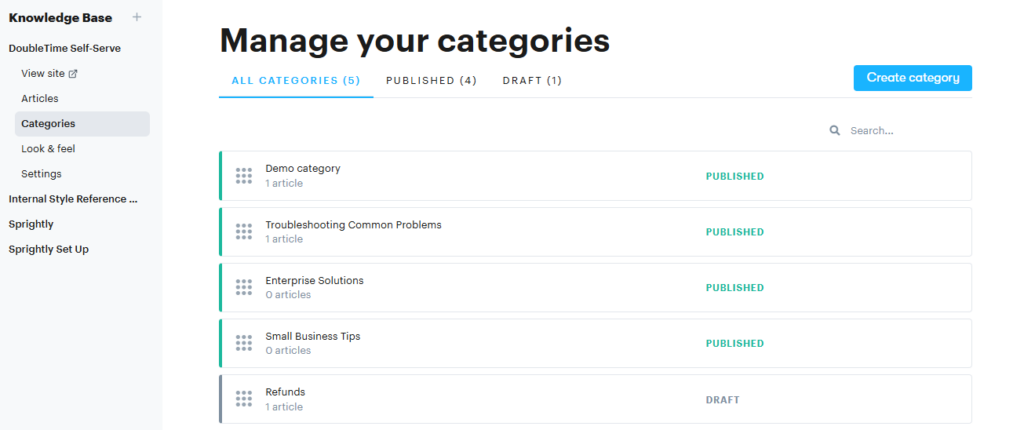
Select Create category, and give it a name and description:
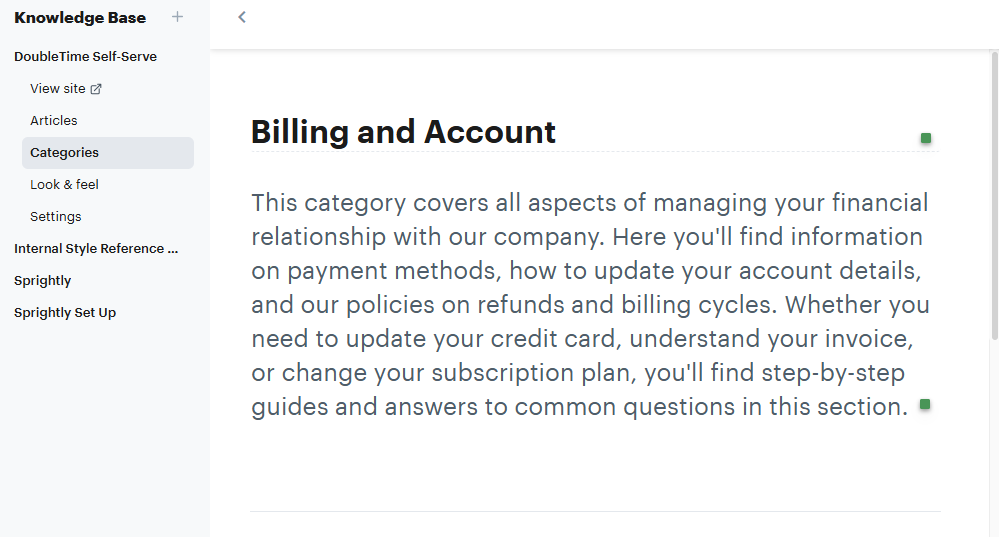
Then you can create as many categories as you need to organize your knowledge base. Every article you write can be assigned to one of these groupings.
Once you have your categories in place, it’s time to think about how you’ll present information within each article. Groove offers a user-friendly editor that allows you to structure your content clearly.
To get a feel for what’s available, select whatever category you want to work on and choose Add Articles:
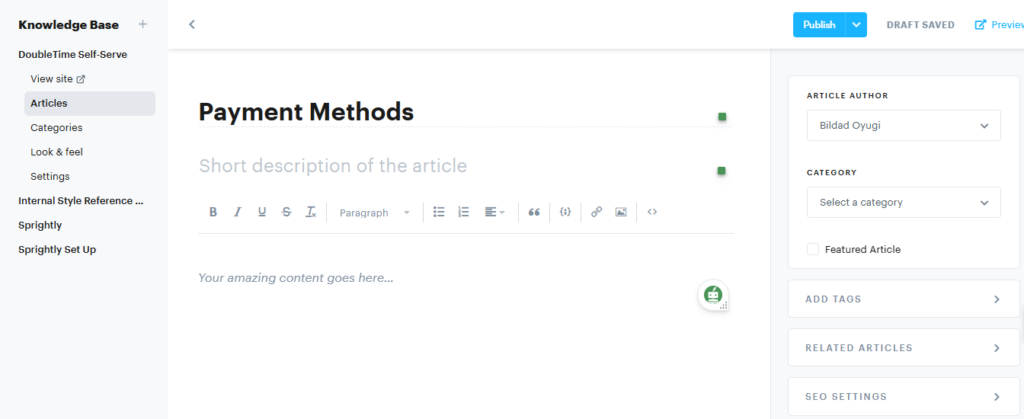
Here you can easily create:
- Clear and descriptive headings and subheadings
- Bulleted or numbered lists for easy scanning
- Visual aids via embedded media
It’s best to use consistent formatting across your articles, to create a cohesive experience for users. So before you start the writing process, considering building an overall content layout (with your team’s input). Now is also a good time to think about your desired customer service branding and support voice.
Finally, you might want to customize your knowledge base’s settings. In Groove, everything is set up to run automatically, with no coding or design work required. But since this is an internal knowledge base, check out the permissions settings – you may want to restrict access so your customers don’t stumble across it.
Step 4: Populate Your Knowledge Base with High-Quality Content
Now that you’ve set up a clear structure in your internal knowledge base software, it’s time to fill it with valuable content!
To craft a high-quality article in Groove, click on Articles to the left of the Knowledge Base menu. You’ll select Create Article, then choose a category. For our example, we’ll create an article under Billing and Account:
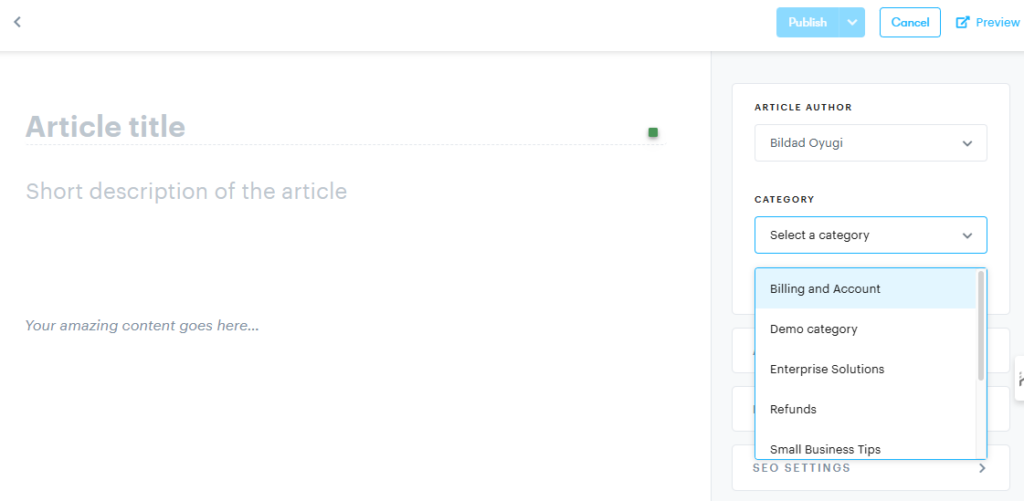
With that sorted, we can write a clear and descriptive title, such as “How to Update Your Credit Card Information”. Then it’s time to add content:
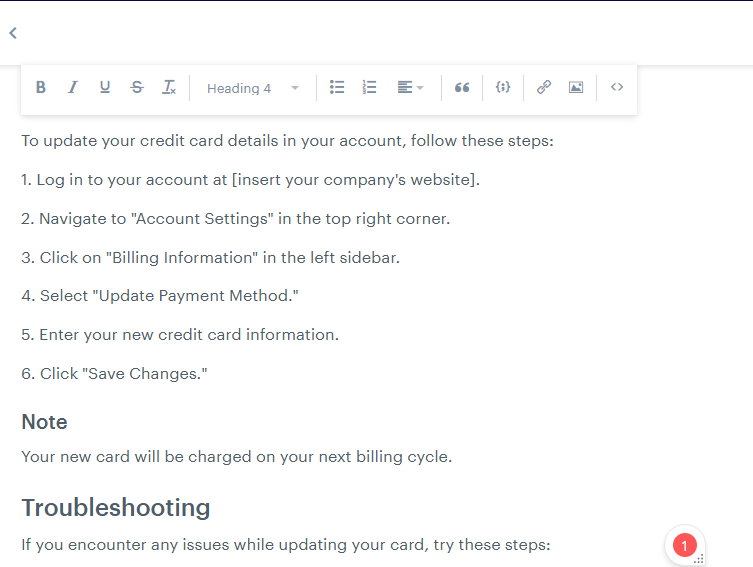
Here are some tips for making your articles effective:
- Use simple and straightforward language. Avoid technical jargon unless it’s absolutely necessary.
- Keep paragraphs short and focused on one idea each.
- Break down complex processes into step-by-step instructions.
- Use bullet points and numbered lists for easy scanning.
- Include relevant screenshots or videos to illustrate steps visually.
To add media, you’ll select the Image icon from the formatting tools menu:
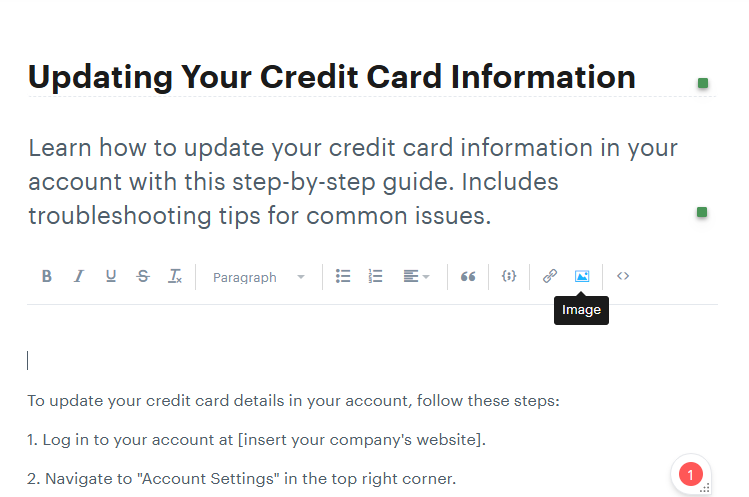
Once you’ve selected an image, you can crop and rotate it. Upload the image, and it’s now part of your article:

Once you’re satisfied with your content, you can assign the article relevant tags to make it easier to find. We’ll add “billing”, “credit card”, and “account management” tags:
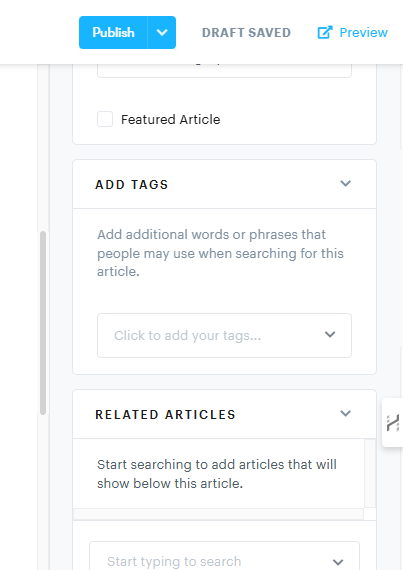
Before publishing, preview your article to ensure that everything looks correct. Then hit Publish to make it live in your knowledge base!
Step 5: Implement and Promote Your Knowledge Base
After populating your internal knowledge base software, it’s time to ensure its effective implementation and promotion across your organization. This involves training your support team, and integrating the knowledge management system into your daily operations.
Begin by organizing comprehensive training sessions for your team. These sessions should cover:
- Navigating the knowledge base structure
- Using advanced search features
- Accessing and applying information during customer interactions
- Contributing new content and updating existing articles
To foster a culture where your internal knowledge base becomes the go-to resource, consider incorporating its usage into your team’s key performance indicators (KPIs). Groove’s analytics dashboard tracks usage metrics, and makes it easy to measure and reward engagement:
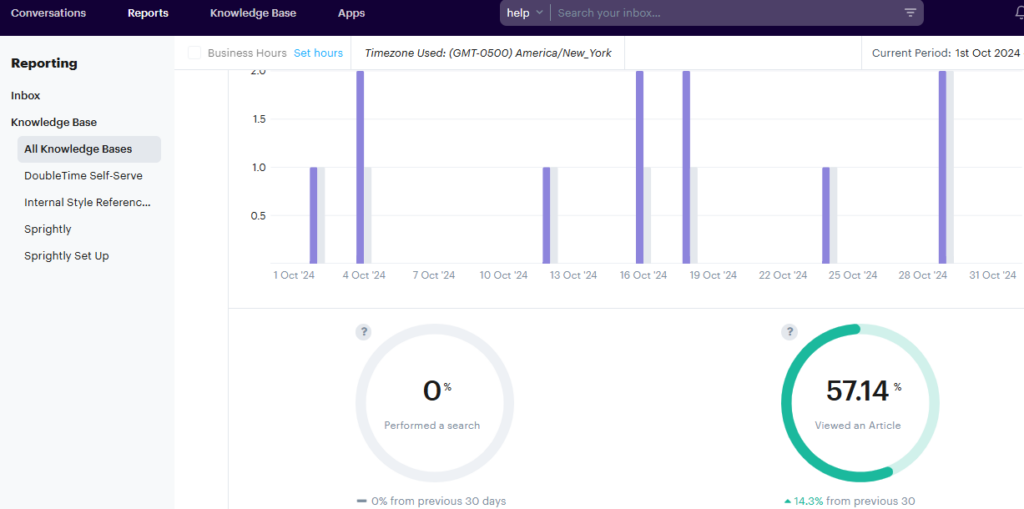
You might also implement a recognition program for team members who actively contribute to and use the knowledge base. This could involve monthly awards or public acknowledgments during team meetings. This creates positive reinforcement that encourages continued engagement.
Additionally, make it a practice to regularly share success stories that demonstrate how the knowledge base has improved customer support efficiency and quality! These real-world examples can inspire your team, and reinforce the value of the knowledge management system in their daily work.
Step 6: Maintain and Update Your Knowledge Base Regularly
If your internal knowledge base is going to remain useful over time, you’ll need to maintain and update it regularly. Let’s focus on two key strategies: conducting content audits and gathering feedback.
Conduct Regular Content Audits
Content audits are crucial for keeping your knowledge management system accurate and relevant. Here’s how to get started:
- Set a schedule. Plan to audit your entire knowledge base at least twice a year. For rapidly changing information, consider quarterly reviews.
- Prioritize content. Use Groove’s analytics to identify your most-viewed articles. Start with the high-impact pieces to ensure that your most accessed information is up-to-date.
- Create an audit checklist. Include items like:
- Is the information and media still accurate?
- Are all links working?
- Is the article format consistent with your current standards?
- Does the content align with current company policies and procedures?
- Assign responsibilities. Designate subject matter experts for different areas of your knowledge base. This way, they’re responsible for reviewing and updating content in their domains.
- Update and optimize. Based on your audit findings, update the content. Use this opportunity to optimize articles for searchability by refining titles, headings, and keywords.
Gather and Implement Feedback
Feedback is invaluable for improving your knowledge base. Here’s how to effectively collect and use it:
- Use Groove’s feedback features. Enable the built-in feedback option at the end of each article. This allows your team to rate the helpfulness of the content and provide comments.
- Analyze user behavior. Use analytics to track which articles are frequently accessed, and which ones users quickly abandon. This can indicate where improvements are needed.
- Conduct internal surveys. Quarterly, ask your support team about the knowledge base’s effectiveness. Focus on questions like:
- Which articles do you find most useful?
- What information is missing or hard to find?
- Have you encountered any outdated or inaccurate information?
- Review customer support tickets. Regularly analyze tickets to identify recurring issues that aren’t adequately addressed in your knowledge base. This can guide the creation of new articles and the improvement of existing ones.
- Implement changes promptly. Act on the feedback you receive! Assign team members to update articles or create new content based on the insights gathered.
Boost Your Customer Support with User-Friendly Internal Knowledge Base Software
Phew! We’ve covered a lot of ground, haven’t we? From setting up your internal knowledge base to keeping it fresh and relevant, you’re now equipped to transform your customer support game.
By embracing internal knowledge base software, you’re nurturing a smarter, more confident team and paving the way for happier customers. It’s about creating a resource that grows and evolves with your business, making everyone’s lives easier—your support team, your customers, and yes, even you.
Remember, great support isn’t about having all the answers. It’s about knowing where to find them.
Ready to take the plunge? Groove’s got your back. Our knowledge base software is designed for small businesses aiming to make a big impact.
Take Groove for a test drive with our free trial, and see how it can transform your customer support story!




